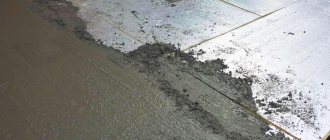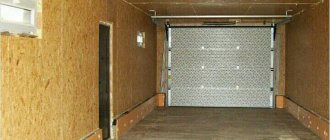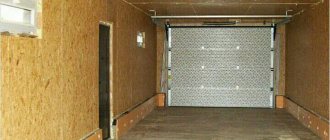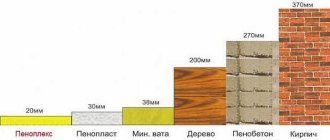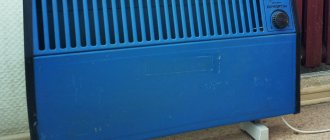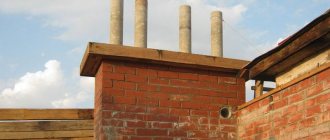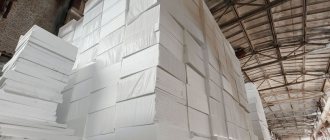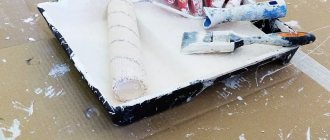DIY marble floor in the garage
Most often, a concrete floor is made in the garage, which is characterized by increased strength and wear resistance. The only drawback of a concrete floor is extreme dustiness. During operation, a lot of dust rises, which greatly interferes.
There are several ways to solve this problem. For these purposes, many people iron the floor, or treat it with special materials that will prevent the formation of dust in the future.
The “recipe” discussed in this article from a construction magazine will help not only get rid of dust on a concrete base, but also make it look like marble.
Necessary materials
To prepare coatings, you will need two main components: polystyrene foam (expanded polystyrene) and solvent. The latter can be acetone, xylene, orthoxylene, butyl acetate, and there are also recipes based on gasoline. Additionally you should take:
- unnecessary capacity;
- wooden stick;
- a piece of gauze.
The easiest way to dissolve polystyrene foam is in xylene, orthoxylene; it is much more difficult to do this in other solvents. In addition, homemade gasoline-based varnish turns out to be jelly-like and is only suitable for applying a fairly thick layer to surfaces. It is better to use it not for painting products, but as glue.
Sequence of actions during operation
To paint the outside and inside, select the desired type of composition. After choosing, you can start painting the product yourself. The easiest way to do this is to use a product in an aerosol package.
To paint polystyrene foam with your own hands, it is best to choose spray paint
Before starting work, shake the can for 1-2 minutes and then evenly cover the surface from a distance of 30 cm in 2-3 layers. Each time it must dry and only then can the next layer be applied. This method is considered the simplest if you learn how to work with a cylinder.
If the composition in a jar is used, painting is done using a brush or roller. The required amount of water is added to the paint to achieve a suitable consistency. If several tones are used, the composition should be mixed well before coating to obtain an even color. If the elements are painted in different colors, then the brush must be rinsed well with water each time.
To consolidate the result, you can use varnish. A special water-based varnish is often used in combination with acrylic paint to further protect the surface of the foam.
Making varnish: instructions
To prepare paint and varnish, you should take 70-100 ml of xylene, pour it into a container, occupying approximately 1/3 of its volume. To further reduce the cost of the material, you can combine xylene and acetone (gasoline) equally, or then dilute the thick ready-made varnish with inexpensive solvents. Afterwards the procedure will be as follows:
- Take polystyrene foam and break it into small pieces. The finer the crumble, the faster the dissolution process will occur. The approximate amount of foam is 0.3 cubic meters. dm.
- Press down the foam with a wooden stick so that the pieces are immersed in the liquid. The material will immediately begin to dissolve and gas bubbles will appear on the surface.
- You can add more polystyrene foam so that the consistency of the product resembles sour cream or liquid honey. High-quality varnish flows from the stick like a thread and does not separate into drops.
- Cover the varnish with a lid and leave for 20-60 minutes to infuse. The color should remain transparent.
- Strain the container through cheesecloth. Pour the clean composition into a new container that has a stopper and lid.
Brushes or spatulas are used for varnishing. You can simply pour the paintwork onto the surface and smear it with movements in different directions. The drying time for this product is 5 minutes after application at room temperature. The product can be used after an hour, when complete curing is achieved.
It is recommended to use the finished product for the following purposes:
- varnishing of wooden products;
- increasing the moisture resistance of concrete;
- coating of any painted objects.
You can also make other paints and varnishes using foam varnish. For example, if you introduce small wood shavings into it, you will get a reliable putty for holes, chips, and cracks. You can also make a conductive varnish. To do this, special fine-grained components are introduced into the composition, which, after polymerization, form a film with excellent electrical conductivity. They are usually used on metal, glass, plastic, and wood.
For 100 g of finished paintwork material, add 15 g of powdered silver and fine-grained graphite. Mix the product well until a dark, thick liquid is obtained. Before use, the varnish should be shaken thoroughly so that heavy particles do not settle down.
Making liquid plastic for anti-corrosion coatings with your own hands
While repairing my car, I was faced with the need to protect body parts from rust, while the materials available to me were either expensive or not effective enough. After several days of searching, the question arose, what is stopping me from preparing the composition for the anti-corrosion coating with my own hands. By and large, such materials are liquid plastics, in other words, they are polymers dissolved in organic solvents.
The matter is basically simple. At the first stage, it is necessary to select a plastic and a solvent for it, at the second, grind the raw materials and add a reagent. What happened as a result of the implementation of this idea: read in the review.
Materials and tools used
- Two test jars with tight-fitting lids.
- For large volumes, you can use a bottle (PET) of vinegar or solvent as a container.
- Pieces of various types of plastic: in our case, black is a fragment of the charger case, transparent is plexiglass, gray is from some kind of electronic device.
- Three types of solvents: “646th”, acetone and xylene (for car enamels).
The process of preparing liquid polymer
Using your hands or using pliers, crumble the black plastic; the smaller the fragments, the better. Ideally, it should be turned into powder (flakes) with a rasp.
We carry out a similar operation for plexiglass, putting the pieces into a container for analysis.
Fill the crushed plexiglass with “646” solvents, and the plastic with xylene. We pour enough liquid so that it completely covers the polymer raw material with a small margin. Plexiglas makes a good varnish; you can add a little xylene to slow down its polymerization.
Shake the containers with our compositions thoroughly and leave them in a warm room for a couple of days. The container must be tightly closed to prevent the possibility of solvent evaporation.
After this period, we open the containers and observe the result. Plastic and plexiglass completely dissolved and became suitable for anti-corrosion treatment of metal parts.
We check the properties of the resulting composition: we lower a metal rod into it and see that the liquid plastic has high adhesion to its surface. We apply the anti-corrosion compound with a brush to parts of the car body that need protection from rust. It is better to make a two- or three-layer coating with intermediate maintenance of each layer until completely dry.
During work, it is necessary to observe safety precautions with active chemical liquids. The solvents used have a pungent odor and the room in which you conduct the experiments must have good ventilation. When pouring it into a container, you need to be very careful to avoid contact with the skin and mucous membranes.
Watch the video
Where can foam adhesive be used?
The glue described is often created when there is no glue in the house or it runs out at the most inopportune moment. This substance can also be used in the event of a sudden crack in the roofing material.
Some owners of houses and apartments use the described glue to fasten interior items. For example, this composition can be used to securely fix a cornice on the ceiling. This will reduce work time. After hardening, the composition reliably holds the connected elements together, so you don’t have to worry about them starting to separate over time.
Often this glue is used when installing materials such as extruded polystyrene foam. It is also usually used when fixing ceiling plinths or gluing furniture.
How to make glue
Creating glue is quite simple:
- First you need to find a solvent and pour it into a small container. The size of the container depends on the amount of glue you are going to receive.
- Solvent must be poured into the container. Many people use gasoline to produce glue from the described material.
- After this, it remains to lower the material into the solvent until a viscous substance is formed in the container.
This composition is suitable for fastening various parts and, after hardening, holds them securely for a long time.
You can use a brush to apply glue. For example, such compositions are often used to coat damaged areas of roofing or joints of roofing material. After hardening, the material dissolved in gasoline resembles glass.
There is another way to create the described adhesive composition. To prepare the substance, some homeowners place crushed foam in the area that needs to be covered with glue. After this, it is wetted with gasoline or another solvent. As a result, the material melts and is evenly distributed over the surface. The composition quickly fills all cracks, thanks to which it reliably seals them.
Indoor work
The process of coloring foam products consists of several stages. Before you paint the foam, you need to prepare it. A primer is used for this. An aerosol composition is best suited for this purpose; it is simple and easy to apply to the desired object, the surface dries quickly and can be ready for subsequent work in a short time. This product is ideal for priming the desired element indoors.
Before you start painting parts, you need to prime them with an aerosol composition.
At the very beginning of work, you need to clean the surface with a damp cloth and wait until it is completely dry. When using an aerosol primer, it is recommended to shake the bottle for a few minutes before application and then coat the material with it.
The composition is sprayed quickly, applying a thin layer at a distance of 20 cm from the product. 3-5 layers of primer are enough to get a high-quality coating. After this, the material must dry completely. This takes approximately 30-30 minutes. Various irregularities or drips can be removed with a spatula, lightly touching the surface.
Features of the composition
When making glue from foam plastic, it is necessary to follow safety rules and carry out all work away from open flames, since such a mixture not only ignites well, but also burns for a long time.
The glue must be well mixed, because if it is not uniform, the objects being glued may not be securely connected to each other. Foam glue can be used to join various materials.
Some people use similar compositions as a protective coating. But the consistency of such a composition should be more liquid. When creating an adhesive composition from polystyrene foam and gasoline, you must remember that it hardens after a few days. The thicker the applied layer, the longer it takes to dry.
Typically, such glue is used when there is no adhesive on hand or it runs out at the wrong time. Some people use various plastic products instead of foam. For example, table tennis balls or disposable cups. To make it more convenient to work with the material, you need to cut it into small pieces or crumble it in advance.
To make the glue dry faster, you should choose acetone solvents for its preparation. After hardening, the composition is able to withstand both low and high temperatures. That is why they can be used to seal cracks in the roof and not worry about them starting to leak moisture again.
What kind of paint can be applied to polystyrene foam?
We touched on this topic briefly, but let's look at it in a little more detail.
Options available on the market:
- Alkyd paints. It is strictly not recommended to use this material, because it is diluted with white spirit, acetone or solvent, and these are precisely “enemies No. 1” for polystyrene foam. Because the surface of the sheets will deteriorate almost immediately.
- Oil paints . They are made on the basis of drying oil, which, in principle, is unlikely to corrode the foam, but the final layer will turn out to be too “glassy” and not very durable.
Please note that oil paints are also bad (in this case) because the dried layer turns out to be inelastic. This means that if the house shrinks or the walls slightly deform, the painted surface will immediately become covered with cracks and chips.
Hence the simple conclusion - paint for polystyrene foam must certainly have such an important property as the ability to slightly stretch the finished layer.
- Water-based paints . In principle, this is the best option for processing such a specific material. Due to the absence of solvents in its composition and due to the fact that acrylic pigments adhere quite well to the surface of the foam. You just need to take into account that such liquids are for interior and exterior use - do not confuse them.
Photo of water-based facade paint
So, it turns out that acrylic paints will be optimally used for painting polystyrene foam. Moreover, based on the specifics of the composition, it is worth trying a specific option: styrene-acrylate water-based products.
Another more or less suitable material is quick-drying acrylic aerosols that do not contain freon. But their price, of course, is higher than that of conventional emulsions.
In principle, we have figured out how to paint polystyrene foam - now we can begin to implement the technology itself.
What type of foam can be used to create glue?
Foam plastic is a group of materials that are foamed masses. Most often they are used for thermal insulation of premises. Depending on the production method, they are divided into 3 main types:
- Pressless. Such products look like a lot of interlocking balls. When such products are physically impacted, the balls are easily separated from each other and the product begins to crumble. This type of foam is most often used to create glue. It easily dissolves in gasoline and acetone and turns into a stretchy mass.
- Pressed. This foam is more durable and does not crumble like the previous type. This is explained by the fact that during production the products are pressed.
- Extrusion. This material has a more uniform structure, since during production the temperature of the products increases. The result is foam plastic, which has a solid structure.
How to make durable paint from foam?
We will need:
– Container for paint,
– You can also add bronze powder for shine.
Pour xylene into a plastic container. Add unnecessary pieces of foam. It is better to work with gloves.
You can use any foam: from household appliances, furniture, tools, etc.
When the foam dissolves, mix well and wait until it becomes transparent. You need to add enough polystyrene foam to make the mixture as thick as sour cream.
Now add any color.
In our case, we also add golden powder. Do as you please.
This paint dries quickly (in 10 - 15 minutes). If the mixture turns out to be liquid, let it sit for a while and start painting.
Metal
You can paint any surface: wood, metal, etc. In our version, we will conduct an experiment on metal and wood.
Degrease the surface first!
You can use a brush or roller. In our version we use a brush. You can see that it is better to still use a roller.
Painted the first layer. We wait for it to dry and after 10 minutes we paint the second and third layers (optional).
Tree
We dilute xylene with polystyrene foam (without adding color) and apply it to a wooden surface.
As you can see, the wood has not changed in color, but shine has appeared (as when applying varnish). The xylene will evaporate, leaving foam behind.
Step-by-step scheme of work
Please note that as an illustrative example, we will consider painting polystyrene foam on the facade, and not inside the room. It will be better this way because we will cover all aspects and nuances - after all, the facade is the most vulnerable spot on the house. Due to exposure to ultraviolet radiation, temperature changes and weather conditions.
This is how polystyrene foam is attached to walls
Let's start working with our own hands.
Surface preparation
Naturally, it is assumed that the polystyrene foam is already fixed on the plane and holds firmly. And not only due to the glue, but also due to the umbrella dowels.
What is important to do here is to first level the surface as much as possible, that is, try to level the plane in the area of the seams (usually these are the places where the largest differences are observed), at those points where the dowel heads are located, etc.
Next, you need to clean the sheets from any dirt and dust, and then prime them with a regular acrylic primer. It should be understood that the liquid will not be particularly absorbed inside the polystyrene foam structure, so you can apply it not very carefully. And much of it is pointless to use for the same reason.
Important! Since the primer does not linger on the surface of the sheets, but simply flows down, drips and dried drops will naturally remain on the surface. Therefore, after the soil has dried, you need to walk along the foam with a spatula and remove all these points.
If this is not done, then the paint will seem to repeat the relief of all the droplets, and this will not look nice.
In general, if the sheets are primed and completely dry, then you can start painting them.
Advice: if you do not have the opportunity or time to putty the entire area of the sheets, then try to at least process the seams between them. This is inexpensive and simple - take a roll of putty mesh, glue it along all the seams, and apply the adhesive mass on top of the mesh with a spatula.
This approach will make it possible to better fasten all the foam slabs together and ultimately make the plane as “molded” and durable as possible.
Painting the plane
It turns out that painting polystyrene foam itself is a simple and very quick task.
Because the scheme here is quite standard.
- We take a roller, brushes, a paint tray (if possible, it will be faster and better to work with a spray gun).
- We tint the material to the desired color and pour it into the bath.
- Apply paint to the entire surface of the sheets using a roller. At the same time, try to roll the roller in one direction to eliminate the appearance of streaks.
Standard example of facade painting
- We wait until the first layer dries and apply the second. If the color of the surface turns out to be unsaturated, then perhaps it makes sense to paint everything again - it should turn out well.
In principle, that's all - these are simple instructions.
